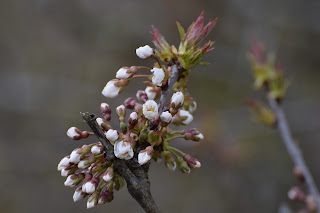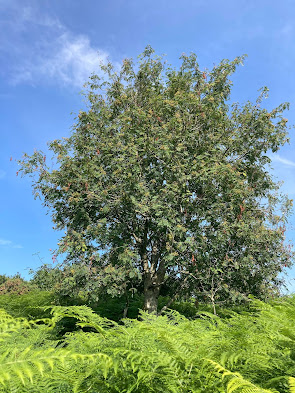Choosing 4,000 trees to plant - part 1 (updated)
Having chosen my 4,200 trees - finally I thought I'd go through my reasoning as I am bound to forget. I am increasing some of those species already there and I am not increasing others and I shall focus on these here. In part 2 I will cover the new species of trees that I shall introduce.
Cherry
There are 3 beautiful large cherry trees which produced the most delicate white flowers in spring & lovely autumn colour leaves. There are no saplings coming up or teenage trees so this species needs support to become more widely established with the introduction of protection from grazers and new genetic stock ie.saplings, I have to say I haven’t spotted any fruit on these three trees this year but I am influenced by this statement on the CWT website:-
Our native tree species provide important links in the food chain for many animals, as well as areas for shelter and nesting. The Wildlife Trusts recognise the importance of healthy habitats to support all kinds of species throughout the food chain, so look after many nature reserves for the benefit of wildlife. (Cumbria wildlife Trust)
Downy birch
There are many downy birch on site although silver birch are more dominant. They clearly thrive here and reading about the conditions they like no wonder - 'damp soil & mountainsides'. I want to plant Scots Pines as I want to introduce a conifer and tip the balance in favour of any red squirrel population in the area; birch are a good deciduous partner to grow alongside these trees, so although there are quite a few on site and they do seem to have reproduced along the beck, including more in the conifer stands works well. They have early catkins enjoyed by pollinators in spring. During the winter, birch seeds are a favourite food for visiting and resident Siskins and Lesser redpolls according to the Cumbria Wildlife Trust.
Elder
I have found half a dozen elder trees; two are quite old. The one younger one flowered this summer and produced just a small amount of fruit. These clearly have not successfully replicated. The flowers provide nectar for a variety of insects and the berries are eaten by birds and mammals. Small mammals, such as dormice and bank voles, eat both the berries and the flowers (Woodland Trust). In time I may be able to pick some flowers for elderflower cordial and possibly use the berries but I shall give the wildlife priority! Currently I cannot reach the flowers or berries as one grows straight up through a yew tree and is too high to reach another overhangs the neighbours field chasing for light, competing with hawthorn trees and the third is in a group of brambles which are spiky!
Many moth caterpillars feed on elder foliage, including the white-spotted pug, swallowtail, dot moth and buff ermine according to the Woodland Trust
Hazel
One of the ‘9 must have top trees for attracting wildlife’ according to Trees Direct, there are some hazel trees along the road edge with evidence that these were coppiced when younger. They have not spread across the site and the trees seems to be a good size and provide good colour on the steep part of the site where I don’t want very tall trees which could take the view away from the middle open area. Hazel fits the bill here well. Their value to wildlife is clear with early catkins and calorific nuts in autumn. There is evidence of some nuts being produced in the past from the ones there but there have not been many this year. Here is a comprehensive description of their benefit for The Woodland Trust website and makes the case well for increasing the number at Bel’s Wood:-
Hazel leaves provide food for the caterpillars of moths, including the large emerald, small white wave, barred umber and nut-tree tussock. In managed woodland where hazel is coppiced, the open, wildflower-rich habitat supports species of butterfly, particularly fritillaries. Coppiced hazel also provides shelter for ground-nesting birds, such as the nightingale, nightjar, yellowhammer and willow warbler.
Hazel has long been associated with the dormouse (also known as the hazel dormouse). Not only are hazelnuts eaten by dormice to fatten up for hibernation, but in spring the leaves are a good source of caterpillars, which dormice also eat.
Hazelnuts are also eaten by woodpeckers, nuthatches, tits, wood pigeons, jays and small mammals. Hazel flowers provide early pollen as a food for bees. However, bees find it difficult to collect and can only gather it in small loads. This is because the pollen of wind-pollinated hazel is not sticky and each grain actually repels against another.
The trunks are often covered in mosses, liverworts and lichens, and the fiery milkcap fungus grows in the soil beneath.
The mention of coppiccing here is interesting. The hazels currently in the wood were coppiced but haven’t been for many year. New trees would need to be well established before they can be coppiced but I will investigate the advantages for the current trees for wildlife.
Rowan
There are some rowan on site but they are such a common tree in Cumbria I think I can introduce more. The individual trees are substantial so once again there is little sign of natural reproduction. Not only are these handsome trees that can live for 200 years which is good for carbon sequestration.
This graph from the Natural England Report published in April 2021 http://publications.naturalengland.org.uk/publication/5419124441481216. is useful for me when thinking of the variety of trees to choose page 19
The Woodland Trust says their value to wildlife is 'The leaves are eaten by the caterpillars of a number of moths, including the larger Welsh wave and autumn green carpet. Caterpillars of the apple fruit moth feed on the berries.’
Flowers provide pollen and nectar for bees and other pollinating insects, while the berries are a rich source of autumn food for birds, especially the blackbird, mistle thrush, redstart, redwing, song thrush, fieldfare and waxwing.
They are a good size. Tolerant of poor weather and deserve a place in the wood.
9 MUST HAVE BRITISH TREES FOR ATTRACTING WILDLIFE
https://www.treesdirect.co.uk/the-vine/9-must-have-british-trees-for-attracting-wildlife/
Willow
There are some superb goat willows on site (including Wilhamena).
They produce early flowers and the bumble bees flocked to her this spring to fill up after hibernation. There are 4 large, mature goat willows - one of which I fear has died but is still standing and another that has fallen over with its roots exposed but still flowered this summer. There are one or two smaller ones but they need a helping hand to become more prolific. They can live for 300 years so are a welcome addition to Bel’s Wood. They require male and female trees to reproduce successfully and with them being sparse on site this is less likely to happen.
There are some other willow trees but I have found distinguishing them confusing to differentiate. I am taking advice on which to introduce to the site. It is noticeable that they thrive in boggy areas and that is where I will focus the new ones to plant.
Types of indigenous willows which I may have on site or may introduce
White willow |
Grey willow |
Crack willow |
Bay willow |
Whitebeam
This is a tree I was unfamiliar with before I got to know Bel’s Wood. I could not identify the trees in winter and it was a delight to see the leaves come into bud. They are so white and cup shaped and looked like magnolia flowers. I assumed that this is why they are called Whitebeam. Then autumn came and the leave look like white paper blowing on the ground. So white is part of their nature. They also had white flowers in summer.
These trees have the status of being common as they are planting in cities and parks but are considered rare in the wild. Since the few I have seem to do well here it seems a good opportunity to increase the number of them here. The flowers and berries support willdlife including some specific moths.
Silver birch, hawthorns, holly, blackthorn and gorse are all prolific with mature and younger trees across the site and I will not be planting more of these. With grazing having ceased and the erection of a deer fence they should be able to reproduce in the next 10 years. I think bird cherry, which is less prolific inside the boundary but there are many plants locally, will also become established from stock adjacent to the site which produces a large about of seeds. With these species 8 out of 9 of the trees mentioned as the best for wildlife are covered. The 9th one is crabapple and this will be introduced as a new species.
Yew tree
Oaks
Sessile oaks are native to Cumbria and I have some beautiful mature specimens that are 150-200 years old (using the Woodland Trust reckoner). There are some well established 50-100 year old trees and some teenagers. When I visited Carrifran in Moffat I talked to Philip Ashmole (http://carrifran.bordersforesttrust.org/make-a-donation/puchase-the-carrifran-wildwood-story/ ) who has driven the project with his wife Myrtle. He talked to me about the difficulty in being sure that acorns and saplings introduced would be sessile oaks not pedunculate or hybrid ones. Some nurseries believe it is not possible to keep these separate any more. I am confident that all of mine are sessile so it seems sensible to take a natural rewilding approach here, which has been successful to date, rather introducing new stock which may not be sessile.
I will do a further blog on the new species of trees that I am planning to introduce.




































Comments
Post a Comment